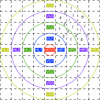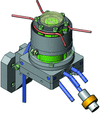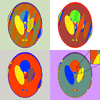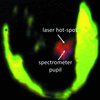issue contents
November 2018 issue

Cover illustration: CAD drawing of a new ultralow-temperature setup dedicated to soft X ray absorption spectroscopy and X-ray magnetic circular dichroism experiments (see Kappler, Otero, Li, Joly, Schmerber, Muller, Scheurer, Leduc, Gobaut, Poggini, Serrano, Choueikani, Lhotel, Cornia, Sessoli, Mannini, Arrio, Sainctavit and Ohresser, pages 1727-1735).
facility information
feature articles
Open  access
access
 access
accessDetails of the High Energy Photon Source (HEPS), a 6 GeV green-field diffraction-limited storage ring light source to be built in China, are presented.
research papers
The extension of the wave zone of synchrotron radiation is studied.
A laser accelerator based on an electron cyclotron resonance maser is described. Important losses that give rise to saturation length and saturation power are included in the analysis. The results are compared with results from an inverse free-electron laser accelerator.
Open  access
access
 access
accessA new apparatus for total scattering measurements has been developed with a variable camera length using a 16-inch two-dimensional flat-panel detector to observe structural changes in amorphous and disordered crystalline materials substantially in real time on beamlines BL08W and BL04B2 at SPring-8. This paper presents the successful time-resolved pair distribution function analysis at SPring-8, and a newly developed program for data conversion from two-dimensional images into one-dimensional total scattering patterns.
The theory of a long set of X-ray compound refractive lenses is developed further. The rocking curve and spatial coherence properties are calculated in the general case of a long compound refractive lens by means of recurrence relations. Coincidence with experimental results is achieved.
A chemically neutral low-pressure RF plasma cleaning technique for Ni, Rh and Al reflective coatings is presented. The successful carbon contamination cleaning of thin Al filters (100 nm thickness) for FEL and EUV applications is also demonstrated.
Using the Timepix3 ASIC ability to detect photons one-by-one, it is possible to take advantage of the charge-sharing effect to achieve subpixel positioning of single-photon events. A Timepix3 pixel (55 µm × 55 µm) was found to be sensitive to pencil beam (5 µm × 5 µm) steps of 5 µm. For a sample size of 1000 photons, the best result is achieved at 120 keV, where a beam step of 4.4 µm ± 0.86 µm was measured.
A compact ultrahigh-vacuum molecular-beam deposition system has been developed for the in situ synthesis of organic thin films and multilayers. The system incorporates all the features necessary for controlled organic thin-film growth.
A description of a flexible sample cell for time-resolved grazing-incidence X-ray scattering and X-ray reflectivity measurements is presented. The cell is especially designed for studying drying kinetics, solvent vapor annealing and hydration processes.
An in situ catalysis powder X-ray diffraction cell compatible with scattering beamlines at the Stanford Synchrotron Radiation Lightsource has been designed, fabricated and tested. The experimental cell's performance was tested by the characterization of a silica-supported Co catalyst for Fischer–Tropsch synthesis and demonstrated that metallic Co can be carburized at a faster rate at 20 bar compared with at ambient pressure.
This study compares, for the entire soft X-ray range (300–8 keV), experimentally measured grating efficiencies with rigorously calculated predictions taking into account the real non-ideal profile of the grating grooves. Special attention is paid to the tender X-ray regime (photon energy 2–8 keV), where data for both grating orientations with the incident beam parallel and orthogonal to the grating grooves are discussed.
The valence-difference contrast method with X-ray near Fe K-edge was used to determine the cation distribution of Ti0.31Fe2.69O4. Anomalous scattering factors were also experimentally determined in the analysis.
A comparative analysis of Mössbauer experiments in a rotating system between a recent application using synchrotron radiation and usual sources of resonant radiation is carried out.
A combination of bulk- and surface-sensitive X-ray-absorption techniques are used in conjunction with model Hamiltonian calculations in order to experimentally determine the depth-dependent valence in La0.7Sr0.3MnO3 (LSMO) thin film.
The presence of image artefacts within synchrotron-radiation X-ray-fluorescence microscopy is reported here. These artefacts can be attributed to the profile of the X-ray beam; two correction methods have been developed to improve qualitative and quantitative synchrotron radiation X-ray fluorescence mapping and are presented here.
Open  access
access
 access
accessA new ultralow-temperature setup dedicated to soft X-ray absorption spectroscopy and X-ray magnetic circular dichroism experiments is described. Two experiments, performed on the DEIMOS beamline (SOLEIL synchrotron), demonstrate the outstanding performances of this new platform, particularly with regard to the lowest achievable temperature under X-ray irradiation (T = 220 mK).
Fe-bound soil phosphorus (P) is probably often underestimated by LCF (linear combination fitting) conducted on P K-edge X-ray absorption near-edge structure (XANES) spectra, unless inositol hexaphosphate (IHP) adsorbed to ferrihydrite and IHP adsorbed to goethite are included as reference compounds.
Open  access
access
 access
accessA new reactor cell and experimental setup designed to perform time-resolved experiments on heterogeneous catalysts under working conditions that simulltaneously combines XAS, DRIFT and MS spectroscopies are reported.
Open  access
access
 access
accessThe performance of the high-resolution fast-photon-counting Eiger 500k detector for sub-millisecond X-ray photon correlation spectroscopy measurement is demonstrated.
A method is proposed to correct for the counting loss generated by removing distorted pulses in X-ray spectra. The count rate obtained by the pulse repair method is increased by about 3% compared with that obtained by the pulse elimination method, and the sum of the peak area obtained by the pulse repairing method is increased by about 2.7% compared with that obtained by the pulse elimination method.
Combined use of a synchrotron X-ray microbeam-irradiated three-dimensional ROS-oxidant fluorescent gel and confocal laser-scanning fluorescence microscopy provides a comparative track analysis of X-ray-photoelectric nanoradiator radiation between gold and iron oxide nanoparticles. The results suggest potent differential therapeutic effects and tissue damage by dose enhancements from gold and iron oxide nanoparticles in clinical application of radiosensitization of high-Z nanoparticles.
A method to automatically align the angular orientation and linear position of the rotation axis in a tomography setup that correlates image features from different X-ray projections is presented.
With scientific advances, X-ray fluorescence imaging has rapidly been adopted in multidisciplinary research investigating disease-induced changes in the metallome. This, with the apparent lack of prior literature comparing binning (described as a crude but fast approach for visualizing data `on the fly' during collection) with fitting (a refined approach which deconvolutes overlapping emission lines), has created a need to document the differences between both and highlight unfortunate errors and artifacts in interpretation that can arise when the binned answers from data collection are accepted without further refinement by fitting.
X-ray radioscopy/tomography and simultaneous energy-dispersive diffraction are presented and applied to study the evolution of an evolving liquid metal foam. A correlation between bubble formation, foam expansion, foam density evolution, lattice parameters and intermetallic phases can be found.
The first feasibility study on dual-energy computed tomography based on the Thomson scattering X-ray source is reported, and the effective atomic number and electron-density distribution of a standard phantom consisting of polytetrafluoroethylene, water and aluminium is derived.
Diffraction apparatus and experimental procedures for tomography X-ray diffraction imaging of frozen-hydrated biological cells have been established.
Open  access
access
 access
accessAutomatic alignment of projection images with respect to a common rotation axis is fundamental to the quality of nano-resolution tomographic reconstruction. A hybrid algorithm developed herein demonstrates superior accuracy, efficiency and robustness.
This proof-of-concept study on a human-scale chest phantom and fresh porcine lungs with artificial pulmonary nodules demonstrates that local-area in-line free propagation phase-contrast synchrotron tomography of fresh porcine lungs can be performed with an acceptable X-ray dose that would allow for future application in patients while providing spatial-resolution magnitudes higher than currently available clinical computed tomography scanners.
The first characterization of the three-dimensional microstructure in rabbit patella–patellar tendon interface using propagation phase-contrast synchrotron radiation micro-computed tomography is presented.
Phase-contrast X-ray laminography using crystal X-ray interferometry and demonstrative observations of an old flat slab of limestone and carbon paper used for a fuel-cell battery are presented.
A tomography reconstruction algorithm has been proposed that can be used for high-quality reconstruction of multi-gray-level material in `missing wedge' situations without prior knowledge of the gray values and manual segmentation.
beamlines
Open  access
access
 access
accessA double-sided, off-axis laser-heating system for monochromatic X-ray diffraction experiments using a diamond anvil cell has been installed at beamline I15 at Diamond Light Source. Measurements of the pressure–temperature phase diagram of Pb demonstrate the reliability of the setup and the high quality of the data.
The design of a new spatially coherent beamline is introduced and the spatial coherence is analyzed for the whole process by wave optics.
computer programs
Open  access
access
 access
accessSirepo, an open-source browser-based interactive GUI for X-ray source and optics simulations, performed by SRW (Synchrotron Radiation Workshop), is presented.
laboratory notes
A low-cost, flexible and fast method for creating disposable sample cells suitable for in situ X-ray experiments at pressures exceeding 60 bar is presented.


 journal menu
journal menu



























































